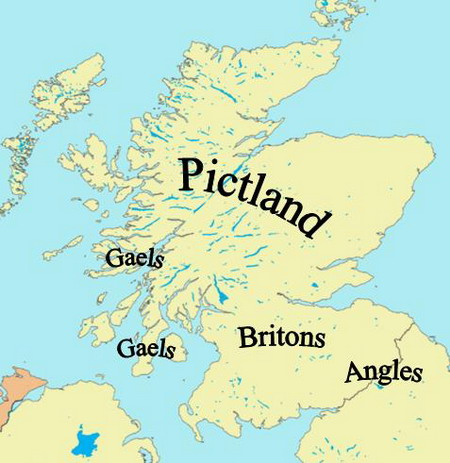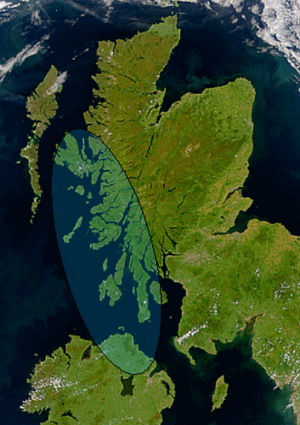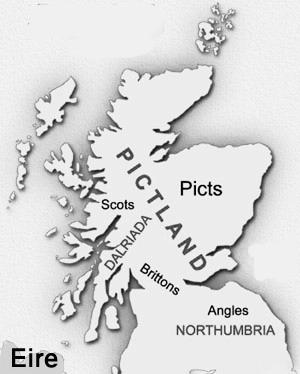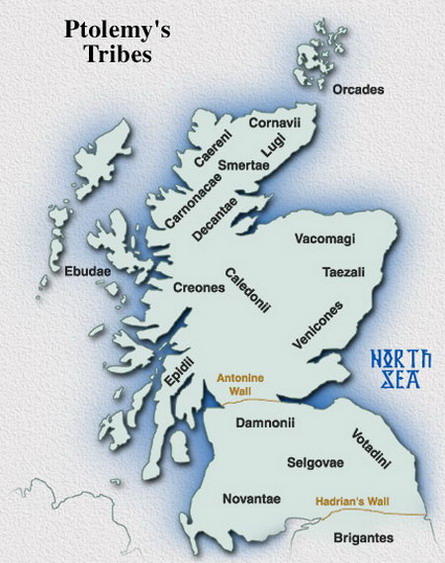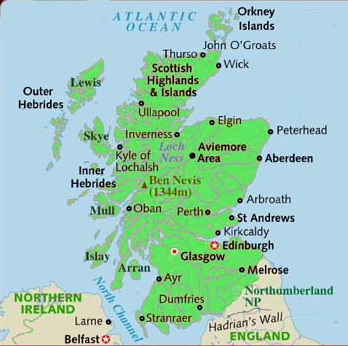a) Constituent Elements
(1. Early Settlers,
Picts,
etc
Roughly speaking at first there were Tribes associated with the Picts in the
North. These were a mixture of peoples and included the Caledonians.
In the south were groups who spoke a type of Celtic similar to Welsh and are
referred to as Brythons.
These groups more or less defeated the Romans and forced the Romans to build
long defensive walls backed by substantial forces to keep them from raiding the
south.
Dal Riada in Ireland and Scotland
(2.
Dal
Riada,
Gaels, Scotti
In the 300s-400s CE a group from southwest Ireland moved to Ulster in
Northern Ireland and from there crossed the seas to occupy Dal Reada on the west
coast. These people were known as the Scotti and gave Scotland its name. Some
say that originally "Scotti" meaning "Wanderer" was another name for Irishmen in
general. One of the meanings of the word "Hebrew" (Ibri) also connotes "Wanderer". From the Geography of Ptolemy, and elsewhere the earliest inhabitants
of both Britain and Ireland were known as Iberi meaning Hebrew. The ethnic name
Iberi was also common throughout the Celtic-speaking regions of Europe
especially in the West. Nowadays the Scotti from Ireland who settled in Scotland
are referred to as the Gaels. The Irish tongue and the "Celtic" language of the Scottish Highlands are both known as Gaelic.
Irish Gaelic and Scottish Gaelic are similar.
(3. Angles, Vandals, Lowlanders and
Vikings
In the 400s and 500s CE groups associated with the Angles and identified
by us (in "The Tribes") as Vandals settled in Northern England and southern
Scotland. In southern Scotland they intermixed with the peoples already there
forming the ethnic group known as "Lowlanders".
In the north Viking settlers from Denmark and Norway intermixed with the Picts
and Gaels.
(4. Other Elements.
In addition to all the above over time settlements of Flemings, Walloons,
Normans, Englishmen, and others were established in Scotland along with a
possible group of assimilated Jewish origin.
b) Tribal Identifications
In "The Tribes" we identified the Vandal-Angle group that moved into the
Lowlands with the Tribe of Asher.
Some of the early Celtic groups in the north that were later taken over by
Scandinavians also pertained to the Tribe of Asher.
The Scandinavians who settled in Scotland appear to have been somewhat different
from those who remained in Scandinavia and may have been dominated by the As or
Aseir who in turn relate to the Tribe of Asher.
In our work "The Khazars. Tribe 13" further evidence is given linking together
Israelites, Scotland, the Picts, Khazars, and Scandinavia.
The Tribe of Manasseh was also dominant in Scotland especially in the Pict and
Gaelic groups.
(c)
Picts,
Alban, Isacon
i.e. Son of Isaac.
Picts
from Agathyrsi
i.e. Khazars.
The Picts or the leading element in what became the Picts came from
Scythia. They were descended from the Agathyrsi who were later known as the
Khazars. The Agathyrsi sent a contingent across the sea to Scotland where it
became identified with the PICTS (Servius on Aenid 4.v.146).
In early Russian the Khazars were referred to as "Hebrews". The Old Russian word
for Hebrew is usually translated as "Jew" which can be confusing if we want to
distinguish between Hebrews from the Ten Tribes and the Jewish People. The
Khazars had traditions that they were of Israelite descent especially from the
Tribes of Simeon and Manasseh.
See:
The
Khazars,
Tribe 13.
http://www.britam.org/Khazarbook.html
Scotland and the Khazars.
http://www.britam.org/KhazarIndex.html
Some type of tradition of Israelite descent probably existed throughout
Scotland. The Biblical laws concerning clean and unclean animals were observed
to some degree throughout Scotland.
See:
The Food Taboos of Old Scotland. The Law of Moses and of Caledonia
http://britam.org/foodtaboos.html
Folklore of the Picts
by Stuart McHardy
http://www.wittins.demon.co.uk/articles/wittins03.pdf
Quotation:
## An account
of the origins of the Picts
which comes from the Irish Book of Invasions or Conquests states that the
Picts
were descended from a Scythian named
Gelon
son of Hercules and that they were called
Agathyrsi.
They supposedly landed in
Leinster in Ireland, helped the
king of Leinster
win a battle against the Tuatha
Fidhbhe
(Fife?) then were forced to sail north into Scotland taking Irish wives with
them on the condition that in any disputed succession the female line would be
dominant...
##In 1879 a book was published called the History of Ancient Caledonia written
by John Maclarren
from Dunning, near the ancient
Pictish capital of
Forteviot.
In this Maclarren
takes one of the wilder explanations for the mysterious origins of the
Picts
- that they were one of the lost tribes of Israel. According to him Daniel and
Lazarus arrived at Montrose in the distant past, bearing with them the Stone of
Destiny and founded a new nation. The fact that he has them accompanied by a man
called McIntyre gives the game away -clan names of this sort are less than a
thousand years old. ##
Chronica
de Origine
Antiquorum
Pictorum
"The Picts
take their name in their own tongue from their painted bodies; this is because,
using sharp iron tools and ink, they are marked by tattoos of various shapes.
The Scots, who now are incorrectly called Irish, are {as it were}
Sciti,
because they came from the Scythian region, and had their origin there; or else
they take their name from Scotta
the daughter of Pharaoh the king of Egypt, who as the story goes was the queen
of the Scots. It is known for a fact that the Britons arrived in Britain in the
third age of the world. However the
Sciti,
that is, the Scots took possession of
Scocia,
or Ireland, in the fourth age.
"Brit-Am Now"-719
#3. Isacon
(Isaac) ancestor of Picts
and Scots
http://britam.org/now/719Now.html
http://www.sacred-texts.com/neu/celt/fab/fab009.htm
Extracts:
# In the Albanic
Duan,
which seems to have belonged to some collection of additions to
Nennius,
and which contains the oldest record of the ethnological traditions of Scotland,
the brothers Brittus
and Albanus
appear as the eponymi
of the two Celtic races inhabiting respectively Britain and Alban, or Scotland.
Thus--
p. 100
"O, all ye learned of Alban,
Ye well-skilled host of yellow hair,
What was the first invasion' Is it known to you'
Which took the land of Alban'
Albanus
possessed it; numerous his hosts.
He was the illustrious son of
Isacon.
He and Briutus
were brothers without deceit.
From him Alban of ships has its name.
Briutus
banished his active brother
Across the stormy sea of Icht.
Briutus
possessed the noble Alban
As far as the conspicuous promontory of
Fothudain."
1
Chron.
Picts
and Scots, p. 57.
The Historia
had said that Brittus
and Albanus
were brothers, and sons of
Hessitio, and that from them
proceeded the nations of the
Britti and the
Albani.
The Pictish
Chronicle adds, after quoting a passage from
Isidorus
giving the etymology of the name
Albani. "de
quibus
originem
duxerunt
Scoti
et Picti;"
1 that is, that both Scots and
Picts belonged to the race of
which Albanus
was the eponymus.
Triads, in which the ethnology of the inhabitants of Britain is conveyed under
the form of successive colonies, or invasions, they are thus represented: "Three
social tribes of the Isle of Britain--the nation (cenedl)
of the Kymry,
the race (al) of the Lloegrwys
and the Brython--and
these are said to be descended from the original nation of the
Cymry,
and to be of the same language and speech. Three refuge-seeking tribes that came
to the Isle of Britain--the tribe of
Celyddon
yn
y Gogled,
the race (al) of the Gwyddyl
that are in Alban, and the men of
Galedin.
A few further extracts of interest from
Skene ch.VII:
THE RACES OF BRITAIN AND THE PLACE OF THE
PICTS
AMONG THEM.
# Brutus, the eponymus
of the Britons, being, in the
Bruts, father of Camber
Locrinus
and Albanactus,
while, in the Triads, the Kymri,
the Lloegri,
and the Brython,
are successive colonies which entered the country from different lands.
# Albanus
possessed it; numerous his hosts.
He was the illustrious son of
Isacon.
He and Briutus
were brothers without deceit.
# Here the two brothers, Brittus
and Albanus,
appear, and the latter is the
eponymus of the inhabitants of
Alban or Scotland, while the tradition of the retreat of the race of the one
before that of the other seems to be preserved.
# And first of the Saxons. It is somewhat remarkable that when
Ammianus
Marcellinus
narrates the first great outburst of the barbarian, or ex-provincial tribes,
against the Romans in 360, he enumerates them as consisting of the "gentes
Scotorum
Pictorumque."
In the second invasion, in 364, they were joined by two other nations, and
consisted of the "Picti
Saxonesque,
et Scotti
et Attacotti;"
and in the third invasion, in 368, of the "Picti
in duas
gentes
divisi
Dicaledones
et Vecturiones,
itidemque
Atticotti
bellicosa
hominum
natio,
et Scotti
per diversa
vagantes."
# Claudian,
in writing of the same invasion, expressly mentions the
Saxones
along with the Picts
as forming part of the ravagers, and names the Orkneys as their seat.
"------- Maduerunt
Saxone
fuso
Orcades,
incaluit
Pictorum
sanguine Thule
Scotorum
cumulos
flevit
glacialis
Ierne."
# I have elsewhere shown 1 that the tradition given by
Nennius,
that Octa
and bussa,
the son and nephew of Hengist,
led a body of Saxons past the Orkneys, and took possession of a part of
Scotland, "usque
ad confinia
Pictorum,"
indicated a real settlement of Saxons on the east coast of Scotland as early as
the year 374; and it is not impossible that they may have allied with the
Picts
proper so closely as to form one of the two
gentes
[Dicaledones
et Attacotes?],
and that the Vecturiones
included them.
Brit-Am Note: All the above are
extracts from Skene.
Albanus and Briutus are described as the first conquerors of Britain.
They are the sons of "Isacon".
In continuation Isacon switches with Hesitio
Isacon is another form of Isaac.
Galedin is derived from Gilead son of Machir of Manasseh.
In addition we have the Declaration of Arbroath.
The Declaration of Arbroath
Wikipedia
# The
Declaration of Arbroath
was a declaration of Scottish independence, and set out to confirm Scotland's
status as an independent, sovereign state and its use of military action when
unjustly attacked. It is in the form of a letter submitted to Pope John XXII,
dated 6 April 1320.
Raymond McNair
King David's Everlasting Dynasty!
by Raymond F. McNair
http://www.cog21.org/davidthrone.html
#
Scotlands
most famous national document is her highly prized Declaration of Independence,
also called the Declaration of
Arbroath. King Edward I seized
the Stone of Scone and took it to London in 1296 AD. But the Scots would still
not fully yield to English rule. Edward II, successor to Edward I, appealed to
Pope John XXII to convince the Scottish King, Robert the Bruce, to acknowledge
the English Kings lordship over Scotland. At that time, many Scots were
anti-British, and would not consider yielding to
Englands
supremacy over Scotland.
# When Pope John XXII appealed to the Scots to submit to Edward,
Bruces
nobles wrote the Pope a letter on April 6, 1320, 24 years after King Edward I
had stolen their Stone of Scone.
http://www.constitution.org/scot/arbroath.htm
Extract:
Most Holy
Father and Lord, we know and from the chronicles and books of the ancients we
find that among other famous nations our own, the Scots, has been graced with
widespread renown. They journeyed from Greater Scythia by way of the Tyrrhenian
Sea and the Pillars of Hercules, and dwelt for a long course of time in Spain
among the most savage tribes, but nowhere could they be subdued by any race,
however barbarous. Thence they came, twelve hundred years after the people of
Israel crossed the Red Sea, to their home in the west where they still live
today. The Britons they first drove out, the
Picts
they utterly destroyed, and, even though very often assailed by the Norwegians,
the Danes and the English, they took possession of that home with many victories
and untold efforts; and, as the historians of old time bear witness, they have
held it free of all bondage ever since. In their kingdom there have reigned one
hundred and thirteen kings of their own royal stock, the line unbroken a single
foreigner. The high qualities and deserts of these people, were they not
otherwise manifest, gain glory enough from this...
For an English translation of the Version in full go to:
The Declaration of
Arbroath
1320 by John Prebble
The Declaration says:
# Thence they
came, twelve hundred years after the people of Israel crossed the Red Sea, to
their home in the west where they still live today. ##
Some claim that this sentence implies that they themselves were descended from
Israelites. It does not say this explicitly.
See:
WHO WERE THE SCOTS' by W. E.
Filmer
http://www.ensignmessage.com/archives/whoscots.html
Extracts:
THE HISTORY OF
NENNIUS
The History of Britain, written by
Nennius
some five centuries earlier, would doubtless have been among the books of the
ancients to which reference was made. There, following an account of various
migrations of people from Spain to Ireland, we read (15):
'According to the most learned among the Scots, if any one desires to learn what
I am now going to state, Ireland was a desert and uninhabited when the children
of Israel crossed the Red Sea, in which, as we read in the Book of the Law, the
Egyptians who followed them were drowned. At that period, there lived among this
people, with a numerous family, a Scythian of noble birth who had been banished
from his country, and did not go to pursue the people of God. The Egyptians who
were left, seeing the destruction of the great men of their nation, and fearing
lest he should possess himself of their territory, took counsel together and
expelled him.'
We are then told that this Scythian and his family, after wandering through many
countries, eventually 'landed in Spain, where they continued many years, having
greatly increased and multiplied. Thence, a thousand and two years after the
Egyptians were lost in the Red Sea, they passed into Ireland'.
The Scottish historian, John of
Fordun,
.. in 1385. 'In the days of Moses,' he wrote, 'a certain king of one of the
countries of Greece, Neolus,
or Heolus,
by name, had a son beautiful in countenance, but wayward in spirit, called
Gaythelos,
to whom he allowed no authority in the kingdom. Roused to anger, and backed by a
numerous band of youths,
Gaythelos disturbed his father's
kingdom by many cruel misdeeds, and angered his father and his people by his
insolence. He was, therefore, driven out by force from his native land, and
sailed to Egypt, where, being distinguished by courage and daring, and being of
royal birth, he married Scota,
the daughter of Pharaoh. Mother Chronicle says that in those days all Egypt was
overrun by the Ethiopians who, according to their usual custom, laid waste the
country from the mountains to the town of Memphis and the Great Sea; so that
Gaythelos,
the son of Neolus,
one of Pharaoh's allies, was sent to his assistance with a large army; and the
king gave him his only daughter in marriage to seal the compact' (History of
Scotland, Transl,
Skene,
1872, pp. 6, 7).
Gaythelos,
therefore, assembled his retainers and, with his wife
Scota,
quitted Egypt., and as on account of an old feud he feared to retrace his steps
to those parts whence he had come to Egypt, he bent his course westwards' (p.
10).
After wandering for forty years through
many lands, he eventually left Africa and 'embarked in such ships as he could
then get, and went over into Spain', where he built a town by the name of
Brigantia
(pp. 11, 12). In Roman times a town of this name existed near
Coruna
in the province of Gallicia
in north-west Spain.
Two sons of Gaythelos,
after first making a reconnaissance of Ireland and returning to Spain, finally
migrated there after Gaythelos
had died. In support of this
Fordun quotes the Legend of
Brandan
as saying:
'Now one of the sons of Gaythelos,
Hyber
by name, a young man but valiant for his years, being incited to war by his
spirit, took up arms, and having prepared such a fleet as he could, went to the
aforesaid island, and slew part of the inhabitants he found, and part he
subdued. He thus appropriated that whole land as a possession for himself and
his brethren, calling it Scotia from his mother's name' (p. 15).
Similar accounts with some differences but sharing essential features are all also found in Irish Mythology and refer to the Milesians
or Sons of Neil who ruled over all Ireland but were concentrated in the north.
In the Scottish context the legends apply to the Gaels who settled in Dal Riada
in the West of Scotland.
McNair tells us:
# In 1879,
Scottish historian John MacLaren
published an interesting history of Scotland titled, The History of Ancient
Caledonia... according to
MacLaren's history, they had
worshipped the 'God of Bethel,' and knew that they were descendants of the
'twelve tribes of Israel,' and say they brought 'Jacob's Pillow stone' into
Britain. According to MacLaren,
some of the Scots kept the 'seventh day' Sabbath, observed the annual Sabbaths
(mentioned in Leviticus 23) and kept the 'Sabbath of the land' every seventh
year, according to the laws God gave Moses to give to Israel; they also refused
to eat any 'unclean food' and paid 'tythes'
(The History of Ancient Caledonia, pp. 1-61). These comments reveal the close
racial connection between the Scotch-Irish and the people of ancient Israel.
# This same historian also says, 'The original writings from which this
history is translated are believed to have been carried away by Edward I, along
with...Jacob's Pillow [the British coronation stone, the Stone of Scone] upon
which the Caledonians crowned their kings at Scone Palace' (p. 2).
More discussion of this matter is to be found in our coming article on Tea
Tephi.
Christianity Against Associations with
Israel
It would seem that in both Ireland and Scotland traditions concerning
their Israelite origin had once existed.
We suspect that the influence of Christianity both kept these traditions alive
while emasculating them.
The Lost Ten Tribes in the eyes of the Church were Jews. Associations with Jews
and with Jewish trends of thought were fought against fiercely. Nowadays one would think that the last thing Ministers, academics, and other modern-day "clericals"
should be worried about is having some of the better members of their communities take an interest in their Hebrew ancestry.
Scotland in Bible Codes.
Points that were noted as linked in the Bible Codes with Scotland include:
Benjamin the brother of Joseph; KEREN: THE HORN OF GILEAD (Manasseh); Out of
Egypt; Caledonia; Becher of Benjamin (or Ephraim); throne; David; Ephraim; Jews;
Kings of Judah; Yamin of Simeon; City of Refuge, baal.
See also:
The Israelite and Scythian Origins of the Scots in Early British Tradition..Nennius.
Scotland
Questions on Scotland
There various traditions in Scotland and Ireland that indicate Israelite Orgins and that dove-tail with evidence from other sources.
Much of this evidence is available from our web-site or from Brit-Am Publications.
We will continue this study concerning Scotland and Israel and add to it.
Those who are interested will find information that is pertinent to Scotland in
our studies of other Western Nations.
This especially applies to Ireland with which Scotland shared an ethnic,
cultural, and historical background.
TO BE
CONTINUED.
For articles on other nations see:
The Earliest West European
Beliefs in their Israelite Origins: Countries Index
To Make an
Offering to Brit-Am
The name "Ephraim" in Hebrew Letters as Seen
by Satellite in the Hills of Ephraim
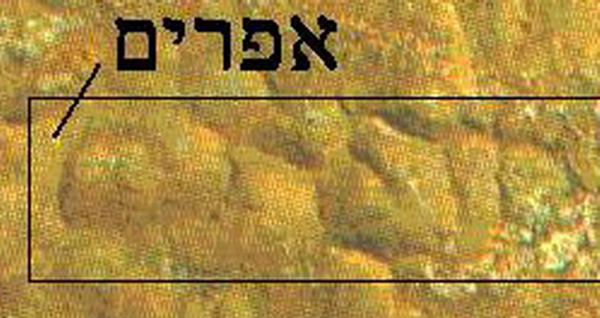
Correspond with us
Send Comments or Criticisms
You may not always receive an immediate answer
but anything you say will be considered and appreciated
Send us an
e-mail
Books and Offering Opportunities
Main Page

